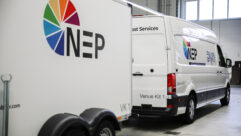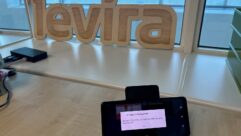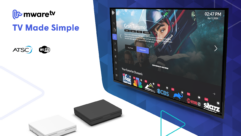
Local Public Broadcast TV Updates Remote Capabilities, Part 2
Apr 9, 2012 5:05 PM,
With Bennett Liles
Listen to the Podcasts
Editor’s note: For your convenience, this transcription of the podcast includes timestamps. If you are listening to the podcast and reading its accompanying transcription, you can use the timestamps to jump to any part of the audio podcast by simply dragging the slider on the podcast to the time indicated in the transcription.
From Sound & Video Contractor Magazine, this is the SVC Podcast show 54 Part 2 with Scott Brosious of Riverside Government TV. Show notes for the podcast are available on the web site of Sound & Video Contractor Magazine at svconline.com. The new remote van at Riverside Government TV covers everything from football to city council meetings and it was not easy deciding on how to equip it to do all of those things. Scott Brosious is back to give us more details on how the new van’s video switching and live transmission works, coming right up on the SVC Podcast. SVC: Scott, thanks for being back with us for Part 2 from Riverside Government TV, the PEG channel out there in southern California and you’ve got your new remote van to cover all kinds of community events. One thing that we didn’t talk about before is how the events are recorded. So how do you do all of your recording in the new GTV van?
Scott Brosious: In the van, we currently have two AJ or AJA Ki Pro recorders which record in AppleProRes on solid state drives so we can either record those, take them back to the computers in the office and output them in our format for electronics or the YouTube or whatever format we are putting them out in. It saves us a lot of time and we don’t have to ingest tapes or anything like that so we can go from the game, so we have a two hour football game we can get it on there pretty quickly right after that. In just the time it takes to compress the game down and copy over to the server and so it’s pretty quick and I love them. I wish I’d had these things for years, having council meetings and long format meetings is always a pain to deal with but with the Ki Pro recorder it’s a cinch. You can get everything up running very fast. [Timestamp: 1:49]
Yeah, I’ll bet there’s a quick turnaround on the ball games. That must call for a real shift in gears between doing football games and doing council meetings. That would really be stepping on the gas and the brakes going from one to the other. So one of the things I was looking at on this is the video-over-cellular transmitter that you were using before. How does that work?
What we use is called a LiveU. It’s a product that we have. It’s literally it’s a backpack. It’s a computer in a backpack. It can be used for a lot of applications. You can use it as a kind of one-man studio truck. You don’t have to send out the truck you can send the backpack. Take your SDI from your camera, plug it into that backpack and it sends it via the cell phone connections. It bonds the cell phone connections together and gives you a big internet pipe so we get on the average around Riverside we get about 2,500-3,000 Kbps. It can send HD video, different frame, different latencies for different applications. So for football we wanted to get the best picture possible. We weren’t really concerned about the delay just because it’s not an interview you’re just watching so we put on the best quality to give you a better picture. It’s a little bit of a delay. I think it’s a 15-second delay from live but on television you’re not going to know because you’re just in the game. You can cut it down—the quality down if you’re doing a lot of more interviews if you’re doing an interview show out on the news you can cut it down to get that latency like a second and since there’s not a lot of action on, not a lot of moving on an interview it’ll keep that latency down and you don’t need such quality of improvement on it. Once that signal comes back to City Hall we actually down convert to it to SD because most PEG channels are unfortunately SD only and then we actually record it into the electronic units themselves so we can actually—we can broadcast it live and record it here at the head ends so that in the event that we wanted to play the game before we can digitize that footage off of the Leightronix decks we can play that already recorded, already pop format right out of the playback system as well. So we actually recorded it in the trucks and at the head ends just to keep things, redundant recording and for certain situations like CIF football they don’t allow anybody other than the loose end providers like FOX Sports West to play the football game live so we can play the game at 11:00 pm being the game ends around 10:00 so we use that recording that we sent back in real time to then playback at 11:00 and then we take the higher end version of the video, the HD recordings, and we compress those down to give you the better quality picture but for right after the production you get a still good recording but faster than we can ever get the feed…the signal downgraded for you. The cellular system works great we use it for football games. We used it for the State of the City which is kind of like the State of the Union Address by our mayor. That was live via that and we also used it for what we call the festival of lights. It’s like a half a million lights on the Mission Inn here in town. We do a big lighting ceremony 50 to 60 thousand people show up in person to see it so we broadcast it live so that the rest of the city doesn’t have to come down town and try to see it from there they can just watch it from home. [Timestamp: 5:04]
And now you’ve got the MotoSAT satellite transmitter. What was involved in getting that installed? That is actually a big process and we’re still in that process for another couple of weeks. We have a, like we said a MotoSAT a motorized satellite dish. It’s not on mast that likes a microwave so ours is—lays flat on the top of the van. We went with MotoSAT because it’s very easy to use. I’m not a satellite technician not of us are here, we’re production people. So MotoSAT has a solution that is very simple to use. We brought it through Clear Channel who is the provider of the service. We had a local supplier install the dish on the van and the associated equipment inside and I was very surprised it’s only three rack units. I was thinking this was going to be a big job but three rack units worth of gear. You just turn it on and once they configured it will geo-synchronize with the satellite. It sets all the settings up itself and you’re kind of ready to go. You just have to turn it on really and it handles everything itself. We are installing a receive dish as well as we speak. We had to pour an eight foot concrete slab two feet thick and run conduit and all that from our receive sight which is right outside of our emergency operation center and then the—I think it’s a 14 and a half foot receive dish will be there and is motorized so we can in the event of an emergency and there’s no time on whatever satellite we’re using it is motorized so they can go to a different dish or a different satellite in the sky so that we always have some way to send video. The thinking behind that was just because in the event of an emergency cell phone systems are—our cellular system will probably not be available in the large scale emergency just because cell phone systems are probably the first thing to go down or overloaded by users so the satellite system, as long as our dish is still re—standing next to our emergency operation center we are good to go. We can book time on those satellites and we can jump around to different satellites if we need to send imaging. We can update our residents of whatever the disaster has happened—stay away from here or get away from here this isn’t—what the situation is and we can even do—we don’t even have to do it publicly if there is a major disaster in our downtown our emergency operation center is far away we can use it for a remote eye for the public safety person out managing their operation center. So they key in real time what is going on in the field anywhere where we deploy the van. [Timestamp: 7:35]
Local Public Broadcast TV Updates Remote Capabilities, Part 2
Apr 9, 2012 5:05 PM,
With Bennett Liles
And I would think that the epicenter of the action is the Broadcast Pix Granite 500 switcher. It sounds like space was pretty tight for a switcher in that van.
It’s a Ford E350 van so it’s not a huge production truck. It’s just your average cargo van. We cram three people in there which is pretty tight. We could probably go four but then you would almost be sitting on each other’s laps. But it works pretty well. The Granite system we really liked. I knew about the Broadcast Pix for years we’d had another unit, the Slate system, for about six years now. The van was a long process. I have been thinking of building a van for years but until we had the funding and the opportunity to do so I have always been planning it in my head what we wanted and when Broadcast Pix came out with the Granite systems all the ideas I had in my head of how can I do it this way, how can I run this—it does everything we need for sports and one person can do it all if you had to. So the art director, if you—like for the…sports is a little harder because you got a lot of graphics and things but for other things like the speeches and the parades and all that one person can run all of it. You can run the director, you can be the engineer, you can be the graphics operator everything from one machine so you don’t really even need the whole truck full of people. You can do it all by yourself with the Broadcast Pix. [Timestamp: 8:54]
Yeah, not hard to be a one man band with that thing and I guess you were using the Slate 1000 for the city council meetings before so the switcher didn’t come as a totally new thing to you.
Yeah, everything the Slate was kind of limited on they have improved and far exceeded what I always wished it could do. The Slate was very advanced for what it was. You could run clips, you could do your own graphics, you could key in everything you want, you can audio follow on the mixer so you don’t have to worry about your audio—they are motorized faders and all that. During council meetings we’ll quite often take breaks and you have to fill that time in a live broadcast like a council meeting so on the new Slate systems they’ve made a lot of things to make that type of situation easier where you can run clips but your clips will auto transition or they will auto correct for the next video so you don’t have to time your video perfectly. You can just let it run and tell it to go and then they come back from their 10-15 minute breaks you can transition back into your show a lot of things that the Slate does now makes things super easy now. [Timestamp: 9:56]
And you’ve got your standard audio stuff in the van. What are your audio capabilities in there, pretty much the interview and taking PA feeds and things like that?
Yeah, pretty much. We also use a CobraNet which is new to me. I’ve never used a CobraNet system where you can transmit 16 audio ins and eight returns over a Ether—standard Ethernet cable so for our announcers, how we do our announcers for the games, we put a break out box right next to them and then we can plug in game audio you can take the feed from the house announcer if you would like and there will be two commentators who do the game play by play in color so we just run all these audio over one cable as opposed to having to run a separate audio line for each one of these people. We also run head phone returns so they can hear each other and hear the director from the truck all over this CobraNet system so it’s something you might have had to use ten audio lines, you do with one. And you can even send audio back which is great, you don’t have to run XLR’s and make sure you get them the right direction and all that. Its one cable, same thing, does everything. It’s all digital, it’s great. [Timestamp: 10:58]
Sure beats dragging a lot of copper around over your shoulder. So how do you handle editing? You were talking a little about that before.
We don’t edit much in the van. We do often bring just a laptop, an Apple laptop with FinalCut Pro since we do shoot everything in the JVC’s which are native FinalCut formats we can drag and drop things in the FinalCut output into MPEG and to get it into the switcher if we need to make the quick adjustment to a commercial or if we need to make a replay, that’s the one thing we’re limited on is replay right now but if we had to we could use the Apple Final Cut system and just drag and drop any video file directly into Granite and it just loads in there. There is no tedious process to get it inputted and loaded in. It’s just drag and drop and it shows up in your bin and you can play that video instantly. [Timestamp: 11: 44]
So have you got anything new coming up for the van?
The newest thing I am thinking of, we still are kind of limited—we have four cameras with graphics and clocks and things we would like to add more cameras just to give us more of that flexibility of sports and once we will be adding instant replay. That was one thing we lacked on this last season of football is that instant replay capability that will be added before the next season starts. One on my dreams is to have wireless cams which would be great so that our sideline guys don’t have to drag that cable. So only one cable now but if we could eliminate that cable with a microwave that would free up that camera guy—that still is a problem is running up and down that sideline when you’ve got 150-200 lb football players with big pads on. You’re still limited by that cable behind you. So if we could go wireless would be my dream and then that camera man could go about anywhere. [Timestamp: 12:36]
Of course, things are going to evolve technically and the hardware and everything as you use the van for different things. Thanks for taking time to tell us about how it’s coming along. Scott Brosious from Riverside Government TV in Riverside, Calif. It was great having you here.
All right, thanks a lot and if anyone would like to see our programming it’s available online at watchriverside.com.
OK, there it is.
Thanks for joining us for the SVC Podcast with Scott Brosious of Riverside Government TV. Show notes can be found on the website of Sound & Video Contractor Magazine at svconline.com. Be back with us next time on the SVC Podcast.










